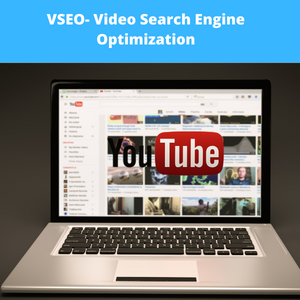VSEO -video search engine optimization, is different from traditional search engine optimization,but many of the same basic SEO principles hold true.VSEO has many benefits for business owners. YouTube is the second largest searchenginein the world and the third biggest site on the Internet (Google and Facebook are #1 and #2 respectively).While most product and service companies have been focusing their searchengineoptimizationstrategies on Google and their social media strategies on Facebook and Twitter, many have overlooked the tremendous video marketing opportunities available on YouTube.YouTube’s engagement numbers are staggering. YouTube receives 1.7 billion unique visitors per month. YouTube receives 14.3 billion unique visitors per month. That’s more than Facebook and Amazon combined. This is what we thought. Here you can find 5 YouTube optimizationsteps for 2022.Step 1: YouTube Algorithm.Unlike Google, where webmasters are encouraged to improve their website’s rank by increasing the number of high-quality sites that link to their pages, YouTube does not consider the number and quality of inbound links.YouTube ranking factors include relevancy of text-based content included in the headline, tags and description fields, the number of videoviews, the number of positive ratings a videoreceives and the recency of upload.VSEO best practices include:.Optimizingtext-based fields such as headline, tags and description by including key phrases people would use to find your video.Increasing the number of views your videoreceives via off-site promotional tactics.Increasing the number of positive (thumbs-up) votes your videoreceives by producing topical, useful or entertaining content.Committing to an editorial calendar that produces new content at a minimum interval of every 7 to 10 days. YouTube videos have a freshness factor that is approximately one week. The freshness factor drops to one week after that. Step 2: Research what viewers want and decide what videos you will produce. There is an endless supply of videocontent online. There is something for everyone, from funny cat videos to cooking tutorials. There is something for everyone, from funny cat videos to cooking tutorials. Whether you’re looking for the latest news or needing help with a project, these videoscan provide valuable information.1.5% of videosearcheson YouTube include the phrase “how to.” That may not seem like much but, according to the YouTube Keyword Tool , it’s nearly five times that of “Justin Bieber.”.57,835,300.Consider producing content that explains, demonstrates or refines the process of how your product or service solves a problem for your customers. Start by listing the problems your customers, visitors, and users face. Next, brainstorm content that explains, demonstrates, or refines the process of how your product or service solves the problem for them. Google Youtube Trends is another option. There are three text fields you can optimize: the header, description and tags. Each field must contain keyphrases that users may use to search for and find your videos. Use the YouTube Keyword Tool for additional intelligence.YouTube text field optimizationtips:.The headline field is 100 characters long. Your brand terms should be included last. The description field can hold 5,000 characters. This is approximately 800 words. The tag field must be 120 characters in length. This is roughly 20 words. Avoid keyword stuffing, which is a common SEO practice for content creation. Use only relevant tags. Your links won’t be clickable unless you include http://. Remember, you must include http:// in your links.Push your videooptimizationefforts even further by adding call-to-action (CTA) overlays at the beginning, middle and end of your videos.Possible CTAs could be a vanity URL like shop[domain]now.com or a coded 800 number specific to your YouTube channel.Step 4: Promote your videosvia embedded posts and influencer outreach.Just as traditional SEO techniques would have us build links to or create buzz around a new web page, blog post or article, the same must be done in videooptimization.According to YouTube research conducted at TubeMogul , 44.2% of videosare found via an embedded post. You can embed your videos into your blog posts, content pages or home page. Remember that the number of views a video gets is a ranking factor. YouTube views are counted the same way as embedded views. Embedded views can increase views by embedding content on your blog, product pages, landing pages, or home pages. Check out the subscriber lists of your competitors and subscribe to their most popular channels. Commenting on the content they upload is a great way to encourage them to comment (and subscribe) to yours.And as with all new web content, promote your videooptimizationefforts via blog posts, Facebook updates and Twitter tweets.Once your content has been created, optimizedand promoted, obsess over YouTube Insight analytics and determine where users discover your videos,who shared them and how often. This data can be very useful in determining your videoconsumers and new influencers.
Google’s algorithm is quite similar. This means that if your landing page or blog post includes a video, that video will also be included in the videorankings. Google will usually treat your web listing and video the same way if you optimize them. Your title will be displayed in search results. It’s important to choose a catchy title for your video. However, it is also important to use keywords in your title. Your video will appear more often when people search for those keywords if your title is more descriptive. Searchresults often reduce titles to 65 characters. Make sure your title includes the most important keywords. Use what people are searching for. If you want people to find your video, it makes sense to use the terms people are searching for. Brad Kremer’s video is an example. He includes the title of the film (“Hayako”) and a short description of the content (“A Time Lapse journey through Japan”). Adding the descriptive, keyword-rich part of the title helped Brad’s videoappear in Google when searchingfor keywords like “Japan timelapse.”.Though the videowas published over a decade ago, “Hayako” has kept a coveted, competitive spot on the first page of Google’s searchresults, proving the power of a search-optimizedvideotitle. However, you should not include unnecessary keywords in your videotitle to increase the chances of it appearing in many searches. This is a bad idea. If your videotitle and description do not accurately reflect the content of your video,searchenginesmay penalize you.What are the average videodescription lengths?YouTube: the description field can contain up to 1,000 characters.Vimeo: can contain up to 5,000 characters.Google: truncates the description of any video(or article) at around 155-160 characters.3. A good description is essential for videoSEO. This is the text that appears in searchresults under your title. Your description should include a hook that grabs the attention of your audience immediately. Also, keep in mind that searchresults will only show the first 110 characters of your description before the description is shortened. You can also credit your cast and crew and note any equipment used in the creation of your video. While these may not boost your searchenginerankings, your collaborators, viewers, and fans can use this information to follow your work on other channels. .Not a copywriter? That’s okay. A blank description is the worst. You should try to convey the most important ideas of your videofirst. Fill in any key phrases you feel people are searching for. For example, if your video is a tutorial on applying a specific skincare product or makeup product, you should start with the purpose of the video. Rufai Ajala, a Vimeo user, does this well in her video “How to Define Your Brows” which she created for Vogue Beauty School UK. Your videoSEO strategy should include chaperoning. Chapters make it easier for viewers to read and skim through video content. This allows viewers to jump to the location they are searching for right from the searchengineresults pages. You can also rank for chapter titles so make sure you do keyword research. Google will automatically cut the chapter title and give you a rank for that term. Google will automatically clip the chapter section title and allow you to rank for that term. Even though your video is hosted on Vimeo, embed it on your website. It is best not to overwhelm a landing page by too many videos. Google will not know which video is the most important. When embedding beautiful videos to your website, make sure you only have one page. Searchengines will also consider the placement of your video on your page. Ideally, your video should be at the top of the page. Video that is “below” the fold, just like the searchresults from Google’s second page, can be forgotten about. This can lead to decreased visibility. Include a videotranscript.Videotranscription is an important part of videoSEO. This gives Google more information about the video content, increasing your chances of appearing in searchresults. Google can retrieve the bytes from your videofile in order to understand your video content, including the spoken words. However, if you have manually transcribed the speech in your video,providing a transcript can help searchenginesunderstand the speech more accurately. If you have manually transcribed the speech in your video, a transcript can help search engines understand it better. Your thumbnail is the first thing people see when you upload your video to Vimeo. A striking thumbnail will not boost your searchresults rankings but it will make you stand out. These tips on film composition are also applicable to stills. A striking thumbnail will attract potential viewers to click through and view your video. Both of these techniques have worked well. We’ve seen both techniques work well. Sometimes you will choose the aesthetic over the analytical option. .8. 8. Tools like Ahrefs and TubeBuddy offer insights into Google. SEO professionals can use Ahrefs to perform keyword research, analyze competitors and track keyword rankings. SEO videomarketing allows marketers to find keyword ideas that have accurate searchvolume and keyword difficulty. They can also access other metrics from Youtube, Google, Yahoo!, Bing, Yahoo!, Yandex and others. Youtube searchvolume can be used to assist marketers in understanding the videosearchdemand for key keywords and topics. This browser plugin allows marketers to make videos more discoverable by searching keywords, related terms and videotags. It is not the Instagram and Facebook algorithms that you hear so much about. Instead, it is a constantly-changing Google searchalgorithms that signals which elements of a website are eligible for ranking. Consider elements such as relevance to the search query, usability, quality, and so on. Google searchalgorithms, which are complex webs that aim to ensure the highest quality results appear at the top of page one, are actually complex. Google crawls your website to gather data. The “crawler” continuously searches the internet for new pages and logs them. as something that can be used for searchresults. A rich snippet is a thumbnail preview of a video that appears in both desktop and mobile Google searchresults. We provide metadata for every video hosted on vimeo.com. This allows your videopreview to appear in Google and other search engines. These snippets are a huge advantage over standard listings. The organic results page is vital for many websites and businesses. They provide a link to your video with a still thumbnail, or moving preview. This increases your organic click-through rates (CTR), and drives more views. Structured data, also known as microdata, is a standard way for searchengineshow to index content from a webpage. By providing the right set of structured data, Vimeo allows your hosted videosto appear in searchresults as rich snippets.There are a few other important forms of structured data Vimeo automatically provides that are essential for both SEO and social media marketing:.Schema.org is a shared set of definitions for structured data, supported by Google, Microsoft, Yahoo, and Yandex.Open Graph, Facebook’s markup, is used to determine what info and images are automatically displayed whenever a page is shared in a post.Twitter Cards are markups that pull in images, videos,and text, and displays them in a ‘card’ when a page is tweeted out to the world.To check out all of the videomicrodata automatically generated by Vimeo, just enter a videopage URL in Google’s structured data testing tool .You’ve officially dipped your toe into the vast ocean of SEO. VideoSEO is only one part of your overall marketing strategy for videos. However, it’s easy to make meaningful changes to your content. It’s important to remember that videoSEO is only one aspect of your overall marketing strategy for your videos. .






